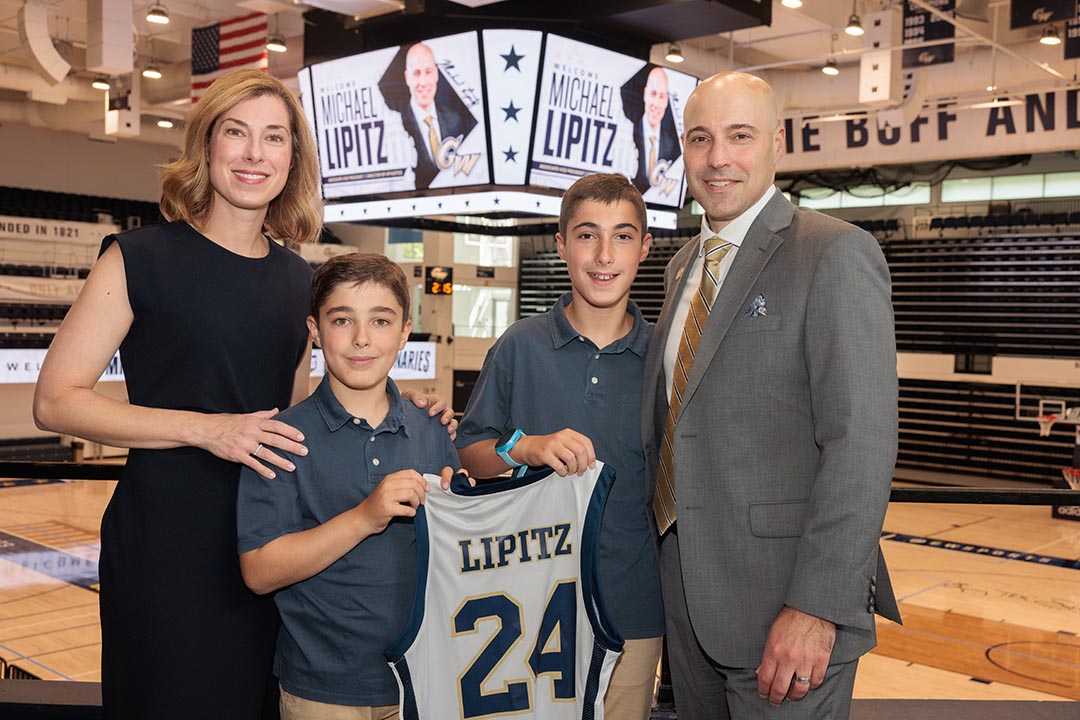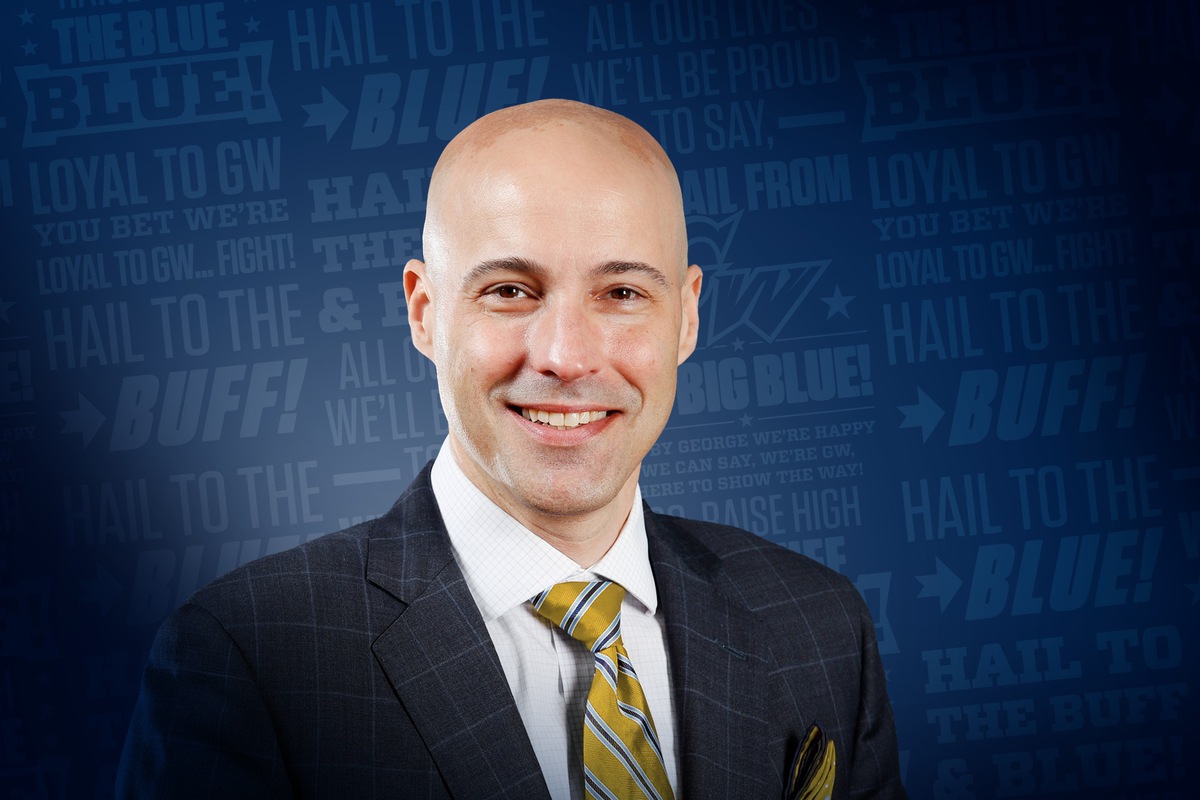Michael Lipitz officially began his duties as the associate vice president and director of athletics at the George Washington University on Aug. 19, and he’s tasked with leading the Revolutionaries during a rapidly changing time in intercollegiate athletics. This includes new opportunities for student-athletes to monetize their name, image and likeness (NIL), the introduction of the transfer portal, Alston educational awards and the coming introduction of revenue distribution units for the women's basketball championship.
Lipitz was previously the director of intercollegiate athletics at the University of Illinois Chicago. He also served in athletics leadership roles at North Carolina State University and the University of Maryland, where he captained the Terrapins’ men’s tennis team as an undergrad.
He spoke to GW Today about the changing landscape of college athletics, what it means for GW moving forward and his priorities as the leader of Revolutionaries’ athletics. The interview was edited for brevity and clarity.
Q: What does this new landscape of intercollegiate athletics look like, and how have they altered priorities for athletic departments?
ML: We’ve quickly transitioned from very restrictive NCAA rules to a more permissive environment. Many of the changes are long overdue and directly and significantly benefit student-athletes. Most are the result of legal challenges to the longstanding amateurism model of college athletics.
Just a couple of years ago, NIL was a new concept, and now it’s central to college athletics. The schools with the strongest [NIL] collectives tend to have the most talented rosters, which is not coincidental. We must embrace this reality both in support our student-athletes and to benefit the competitiveness of our athletics program. We’re committed to positioning GW for success in this rapidly evolving environment.
Q: So, does fundraising and development play a larger role in today’s athletic departments compared to a few years ago?
ML: Resources have always been vital, but their importance has shifted. Resource allocation is increasingly focused on talent acquisition and retention, particularly in revenue generation sports. The landscape has changed significantly in just five years, with rules around scholarships and NIL opening new opportunities for student-athletes. Whether it's fundraising, ticket sales, corporate partnerships, or other sources, athletically generated revenues are more important ever.
Q: How does GW navigate competing in this environment with Big Ten, ACC, SEC, Big East and Big 12 schools that have larger budgets and collectives for athletics, especially when it comes to recruiting and retention?
ML: College students have always had the opportunity to transfer. The open transfer environment is only new for student-athletes in college athletics. Now there's free movement, but you also have the monetary component in that many student-athletes are being financially incentivized to transfer.
I understand that from a fan base standpoint today’s transfer environment can be frustrating. But it’s the new normal. We’re in an era of constant roster building and continual culture building to maintaining and elevate a program. Part of the opportunity to achieve the best possible roster stability ties back to the revenue generation efforts discussed earlier that enable us to invest in retaining our most talented student-athletes.
One area where GW has an advantage is the value of the degree, which helps both retention and recruiting. GW offers a truly unique combination of elite academics and elite, A-10 athletics. Our student-athletes benefit from experiential learning and leadership development in the nation’s capital and one of the greatest global cities, which enhances their overall college experience. The ultimate goal is to excel both academically and athletically, and not every institution can do that effectively. Our ability to deliver both at an elite level is a significant competitive advantage for GW.
Q: During your time at the University of Illinois Chicago and NC State, you oversaw numerous athletic facilities projects. What are your visions for facilities at GW?
ML: We’ve just launched an athletic facilities master planning process with the assistance of HOK, one of the global leaders in sports facilities planning and construction. This initiative will help guide our future decisions and investments to enhance our facilities for both student-athlete development and fan experience. Gathering input from our stakeholders is an important part of that process, as it helps us prioritize our investments for the benefit our student-athletes, alumni, fans, and entire GW community.
A dedicated basketball performance center has been a longstanding need for GW, and it remains our top facilities priority. Men’s and women’s basketball are our flagship programs, and this facility is essential to support their growth. But the athletics facilities master plan will be comprehensive and encompass many other short-term and long-term projects that we’ll pursue to enhance facilities for student-athletes and fans alike.
Q: As you mentioned, men’s and women’s basketball are flagship programs and the main revenue drivers at places like GW. But as we navigate this evolving landscape where revenue generation is crucial, how do you ensure that athletes in non-revenue sports continue to receive the support they need to succeed?
ML: As a former Olympic sport student-athlete, I take great pride in supporting all our student-athletes. GW and institutions across the country are tasked with adapting to a new environment where the revenue-generating sports of football and basketball are increasingly operating very differently. But revenue sports and non-revenue sports will continue to coexist, and we remain committed to maintaining a high-quality academic and athletic experience for all our student-athletes.
Q: Under your leadership, what defining characteristics do you hope to see in GW’s teams, coaches, staff and the athletic department overall?
ML: Our focus will be on three areas. First, academic achievement will always be our top priority. GW student-athletes already excel in the classroom with graduation rates and academic accolades among the best in the nation. Second, we will pursue competitive excellence—GW’s athletic prowess should be recognized alongside its academic achievement. Competitive success gets you noticed, and we’ve seen what that looks like here specifically with basketball. Third, we want to make a significant, positive impact on our campus and local communities. Our student-athletes contribute hundreds, if not thousands, of hours of community service each year, which is vital. Additionally, athletics serves as a rallying point for the university community, fostering a spirit of unity and pride. When GW Athletics succeeds, we bring everyone together and serve as a platform to amplify the outstanding people and work of the entire campus community. If we’re excelling in these three areas—academic achievement, competitive excellence and community impact—we’re on the right track.




